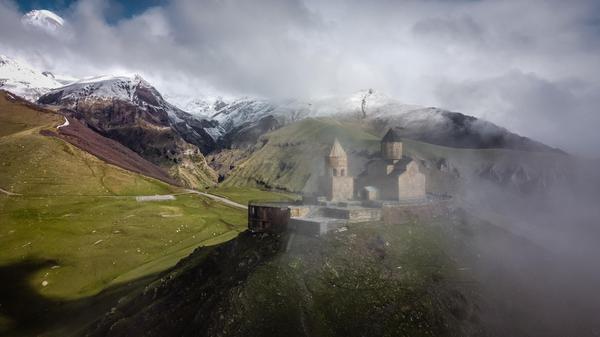Georgia's rich cultural and natural heritage has been recognized by UNESCO, with several sites designated as World Heritage Sites. These sites showcase the country's diverse history and traditions, from ancient cities to stunning natural landscapes. In addition, Georgia also boasts a unique intangible cultural heritage, including traditional music, cuisine, and wine-making. In this comprehensive article, we will explore the main UNESCO Heritage sites in Georgia, as well as its intangible cultural heritage, and discuss the importance of preserving and sharing these treasures for future generations.
Tangible Cultural Heritage
Georgia's tangible cultural heritage is a testament to its rich and varied history. Mtskheta, located just outside the capital city of Tbilisi, was the ancient capital of the eastern Georgian kingdom and an important religious center. The city's two UNESCO-recognized landmarks, the Jvari Monastery and Svetitskhoveli Cathedral, are both beautiful examples of Georgian medieval architecture.
Bagrati Cathedral and Gelati Monastery, located in the western Georgian city of Kutaisi, are recognized for their significance as centers of education and culture during the medieval period. Bagrati Cathedral was built in the 11th century and features stunning frescoes, while Gelati Monastery was founded in the 12th century by King David IV and became a hub of learning and scholarship.
The Upper Svaneti region, located in the high mountains of northern Georgia, is known for its unique defense towers, which were built by local communities to protect themselves from invading forces. The region's many towers, along with its beautiful landscapes, were recognized by UNESCO as a World Heritage Site in 1996.
Kutaisi, one of the oldest cities in Georgia, served as the country's capital for several periods throughout history. The city boasts several landmarks recognized by UNESCO, including the Bagrati Cathedral and Gelati Monastery, as well as the historic district of Tskaltubo.
Finally, Davit Gareja, a complex of cave monasteries located in the southeastern part of the country, is recognized for its stunning frescoes and importance as a religious and cultural center. The monasteries, which were founded in the 6th century by Davit Gareja, have been a pilgrimage site for centuries and are a testament to Georgia's long and rich history.
Natural Heritage
In addition to its tangible cultural heritage, Georgia also boasts stunning natural landscapes that have been recognized by UNESCO. The Colchic Rainforests, located along Georgia's western Black Sea coast, are a unique biodiversity hotspot that is home to several endemic and endangered species. The forests have been recognized by UNESCO for their importance in maintaining the Earth's ecological balance.
The Upper Svaneti region, in addition to its cultural significance, is also home to unique flora and fauna that have adapted to the high mountain environment. The region's alpine meadows, forests, and glaciers support a variety of wildlife, including several species of birds and mammals that are endemic to the Caucasus region. The natural beauty and ecological importance of the Upper Svaneti region have been recognized by UNESCO since 1996.
Intangible Cultural Heritage
In addition to its tangible cultural heritage, Georgia is also home to a unique and vibrant intangible cultural heritage. Georgian polyphonic singing, a traditional form of choral singing, has a long and rich history in Georgia and has been recognized by UNESCO as a Masterpiece of the Oral and Intangible Heritage of Humanity. The haunting melodies and intricate harmonies of Georgian polyphonic singing are a testament to the country's rich musical tradition.
Georgian cuisine is another important part of the country's intangible cultural heritage. Traditional dishes like khinkali (dumplings), khachapuri (cheese-filled bread), and badrijani (eggplant rolls) are enjoyed by locals and visitors alike. Georgian cuisine is characterized by the use of fresh, local ingredients and unique flavor combinations, and has been recognized by UNESCO as an Intangible Cultural Heritage of Humanity.
Wine-making is another important aspect of Georgia's intangible cultural heritage. The country is one of the oldest wine regions in the world, with a history of wine production dating back over 8,000 years. Georgian winemakers use traditional methods of winemaking, such as fermenting the wine in large earthenware vessels called qvevri, and their wines have a unique flavor and character that reflect the country's rich cultural heritage.
Preserving Georgia's Heritage
Preserving Georgia's cultural and natural heritage is a challenging task, but one that is essential for maintaining the country's unique identity and character. One of the biggest challenges facing heritage preservation in Georgia is the lack of funding and resources for restoration and maintenance of historic sites and natural areas. Additionally, some sites are under threat from development and environmental degradation.
Despite these challenges, there have been concerted efforts to protect and preserve Georgia's cultural and natural heritage. The government has implemented programs to support the preservation of historic sites, and several NGOs and community organizations have also been established to promote heritage conservation. In addition, sustainable tourism practices that prioritize conservation and community involvement are becoming increasingly popular in Georgia, providing a way to generate income while also preserving the country's natural and cultural treasures.
Ultimately, preserving Georgia's heritage requires a collaborative effort between the government, civil society, and visitors to the country. By working together to protect and promote Georgia's unique cultural and natural heritage, we can ensure that these treasures are enjoyed by future generations.
Conclusion
UNESCO recognition for Georgia's cultural and natural heritage is an important step towards preserving and promoting the country's unique treasures. By recognizing these sites and traditions as part of the global heritage, UNESCO helps to raise awareness of the importance of heritage preservation and provides a platform for international collaboration.
However, preserving and sharing Georgia's heritage is not just the responsibility of UNESCO or the government, but also of individuals and communities. By valuing and promoting Georgia's cultural and natural heritage, we can ensure that these treasures are passed down to future generations and continue to enrich our lives and our understanding of the world.
In conclusion, Georgia's UNESCO Heritage sites and intangible cultural heritage elements provide a glimpse into the country's rich and varied history and traditions. Through efforts to protect and promote these treasures, we can help to ensure that they are enjoyed and appreciated for generations to come.























